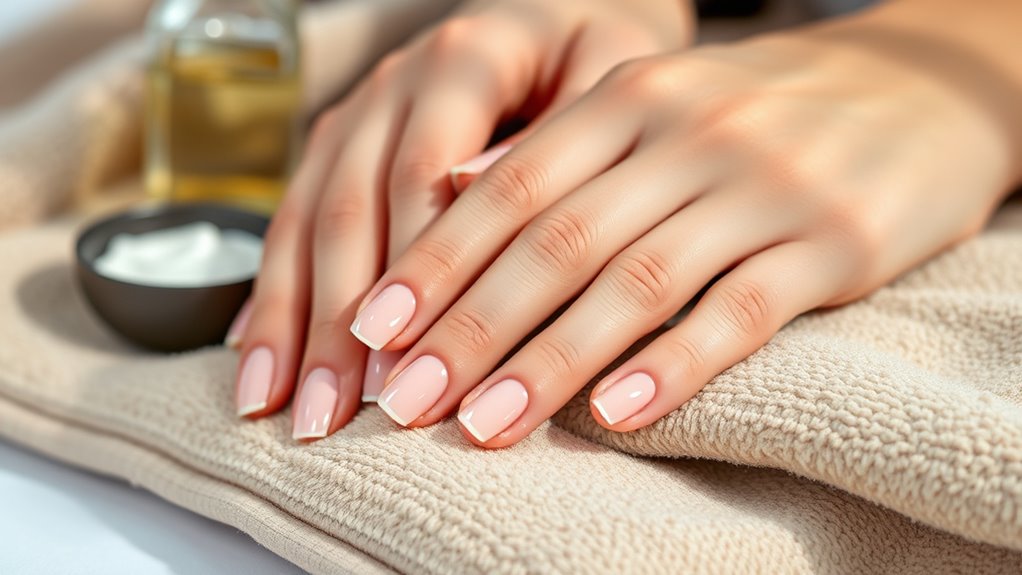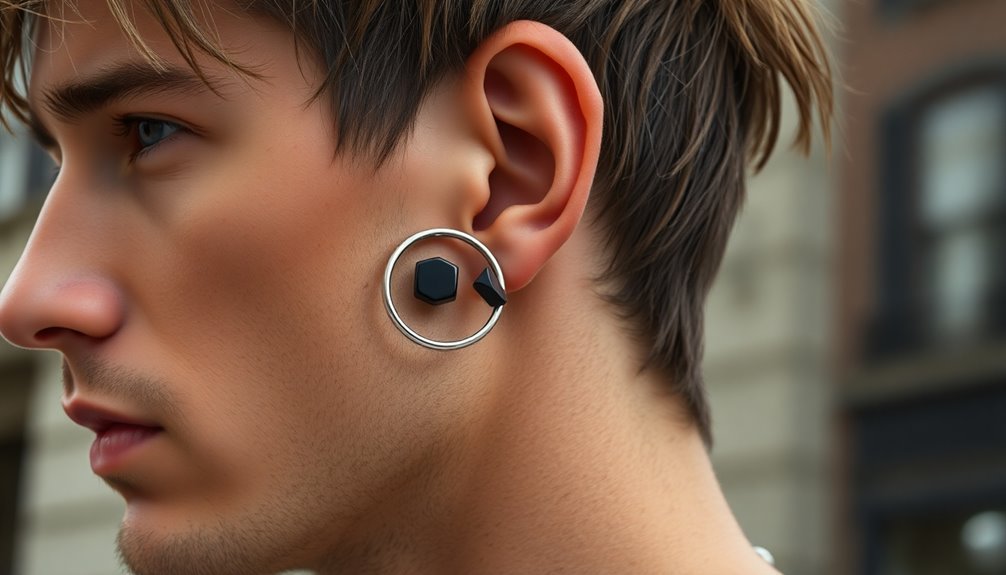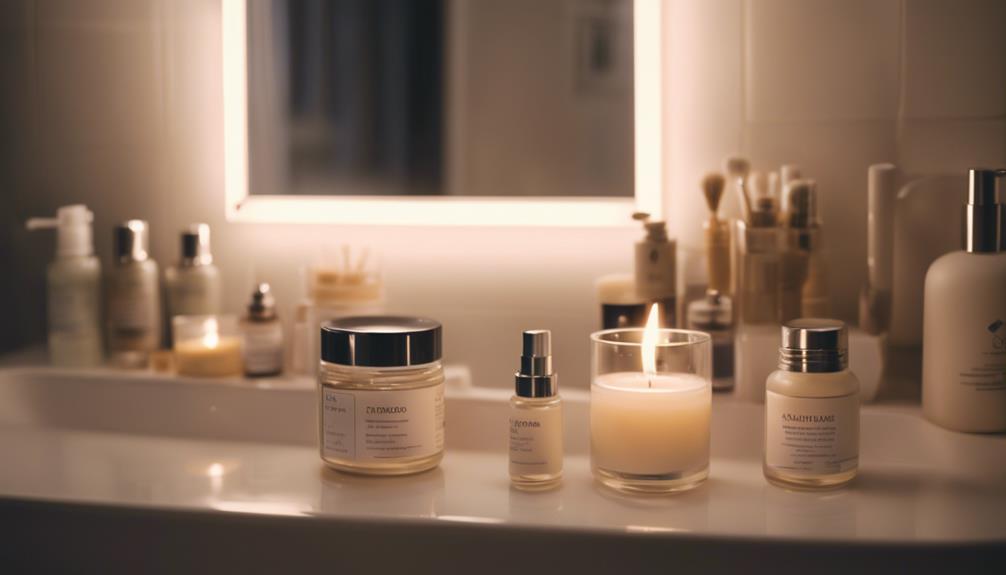To keep your nails healthy and beautiful, focus on good hygiene, regular trimming, and moisturizing. Use gentle nail products free from harsh chemicals and protect your nails from water and chemicals by wearing gloves. Incorporate nourishing oils like vitamin E or jojoba, and maintain a balanced diet rich in vitamins like biotin. Proper filing and nail strengthening treatments also help prevent breakage. Keep learning more tips below to boost your nail care routine further.
Key Takeaways
- Maintain proper nail hygiene by regular washing, trimming, and cleaning under nails to prevent infections and buildup.
- Keep nails moisturized with cuticle oil and hand creams to promote flexibility and prevent dryness or brittleness.
- Use gentle, non-toxic nail products and avoid harsh chemicals to protect nail health and prevent damage.
- File nails in one direction with fine-grit tools to prevent splits and maintain smooth edges.
- Follow a consistent routine of nourishing treatments, hydration, and protective styling to support healthy growth and strength.
Understanding Your Nail Structure
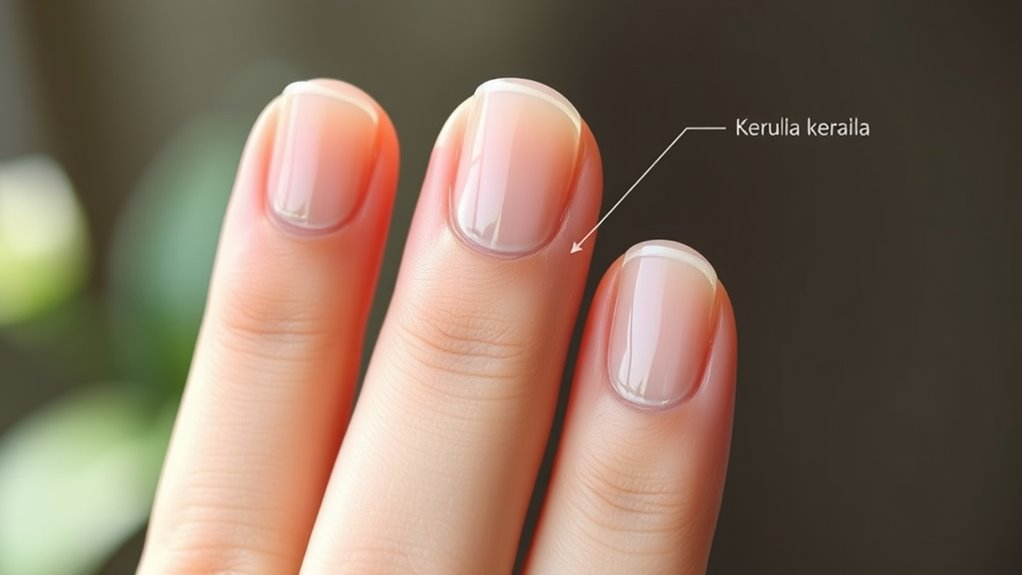
Your nails are more than just a pretty accessory; they have a complex structure that keeps them strong and functional. The visible part, called the nail plate, is made of keratin—a tough protein that protects your fingertips. The nail bed lies beneath the nail plate and supplies nutrients and support, ensuring healthy growth. At the base, you’ll find the cuticle, a protective layer that shields new nail cells from infection. The lunula, the whitish crescent-shaped area, indicates where new cells form. The matrix, located under the cuticle, is essential for nail growth, producing new keratinized cells. Understanding these parts helps you grasp how nails grow and why caring for each component matters for maintaining strength and health. Proper maintenance of the nail structure and avoiding improper disposal of paper towels and wipes can also prevent damage that affects nail health indirectly by reducing stress and ensuring overall hygiene. Additionally, maintaining good hygiene practices can help prevent infections that may compromise nail integrity. Advances in AI-powered diagnostics are also offering new ways to monitor nail health and detect issues early.
The Importance of Proper Nail Hygiene
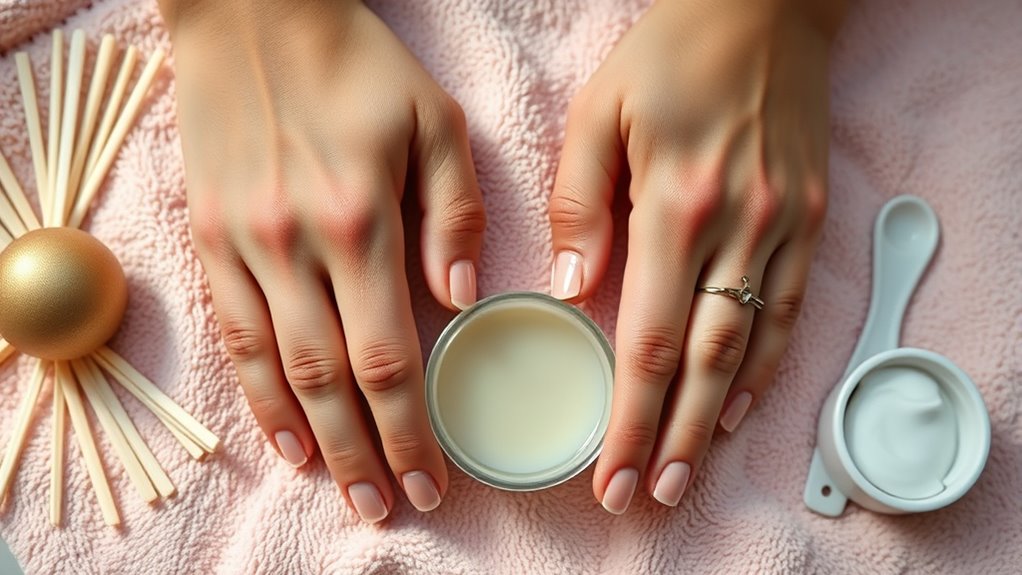
Keeping your nails clean starts with regular hand washing to remove dirt and germs. Proper nail trimming prevents hangnails and reduces the risk of infections. Practicing these habits is essential for healthy, hygienic nails. Additionally, avoiding family photoshoot fails can help maintain neatness and reduce accidental damage during nail care routines. Embracing attention during your routine enhances focus and results, ensuring your nails stay healthy and well-maintained.
Regular Hand Washing
Regular hand washing is essential for maintaining proper nail hygiene because it effectively removes dirt, bacteria, and debris that can accumulate around the nails and cuticles. When you wash your hands regularly with soap and water, you prevent the buildup of germs that can cause infections or damage your nails. Be sure to scrub under your nails gently to dislodge any trapped grime. Dry your hands thoroughly afterward, especially around the cuticles, to prevent moisture from lingering and promoting bacterial growth. Proper hand hygiene also helps keep your nails looking clean and healthy, reducing the risk of discoloration or fungal issues. Making hand washing a routine, especially before and after touching your nails or engaging in activities that expose your hands to dirt or germs, is a simple yet effective way to support overall nail health. Additionally, understanding industry trends can help you stay informed about best practices for nail care.
Proper Nail Trimming
Because proper nail trimming is essential for maintaining good nail hygiene, it’s important to do it correctly. Start by using clean, sharp nail scissors or clippers. Cut straight across to prevent ingrown nails and avoid rounding the edges too much. Don’t cut too close to the skin, as this can cause irritation or infection. If you have thick or curved nails, trim slowly and carefully. After trimming, gently file the edges to smooth any rough spots. Keep your nails at a manageable length to prevent dirt buildup and breakage. Regular trimming helps prevent fungal infections and keeps your nails looking neat and healthy. Using the right tools and techniques can also prevent nail damage and promote healthier growth. Incorporating proper nail hygiene practices such as cleaning your tools regularly can further reduce the risk of infection.
How to Moisturize and Hydrate Your Nails
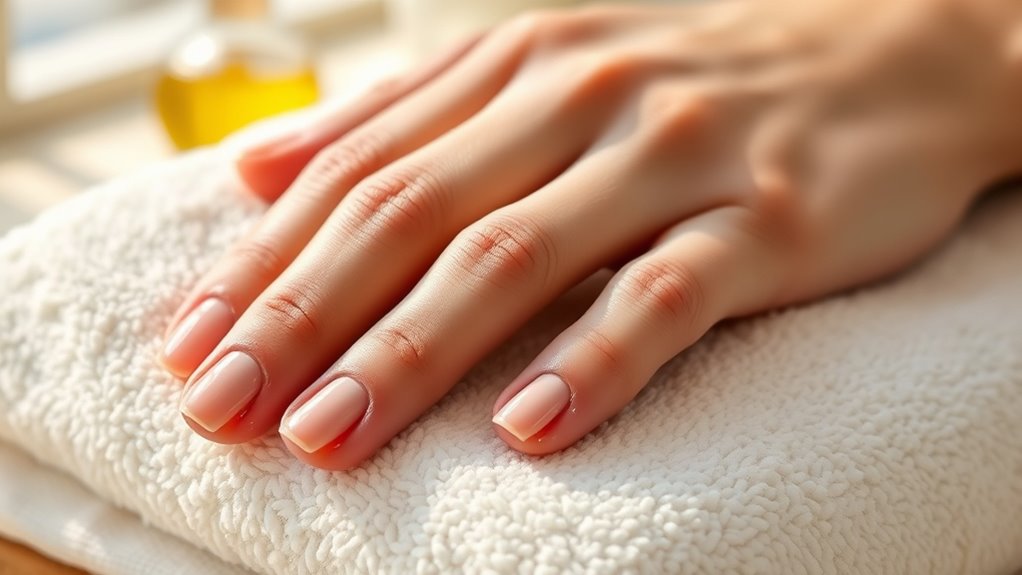
Moisturizing and hydrating your nails is essential for maintaining healthy, strong nails and preventing dryness or peeling. To do this effectively, apply a nourishing cuticle oil or hand cream daily, focusing the product on the nails and surrounding skin. Massage the product gently to improve absorption and boost circulation. The use of products with ingredients like vitamin E, jojoba oil, or shea butter, which deeply hydrate and strengthen nails, can make a significant difference. If your nails feel brittle, soak them in a mixture of warm water and a few drops of oil for five minutes. Regular hydration helps keep nails flexible and prevents breakage. Additionally, maintaining proper nail hygiene can further enhance your nail health and appearance. Proper hydration techniques are also crucial for overall nail health, ensuring your nails stay moisturized from within. Incorporating professional nail care techniques can help prevent infections and support healthy growth. Practicing energetic alignment through positive intentions and mindfulness can also improve your overall nail health by reducing stress-related damage. Remember, well-moisturized nails look healthier and are less prone to damage, so make hydration a daily part of your nail care routine.
Choosing the Right Nail Products
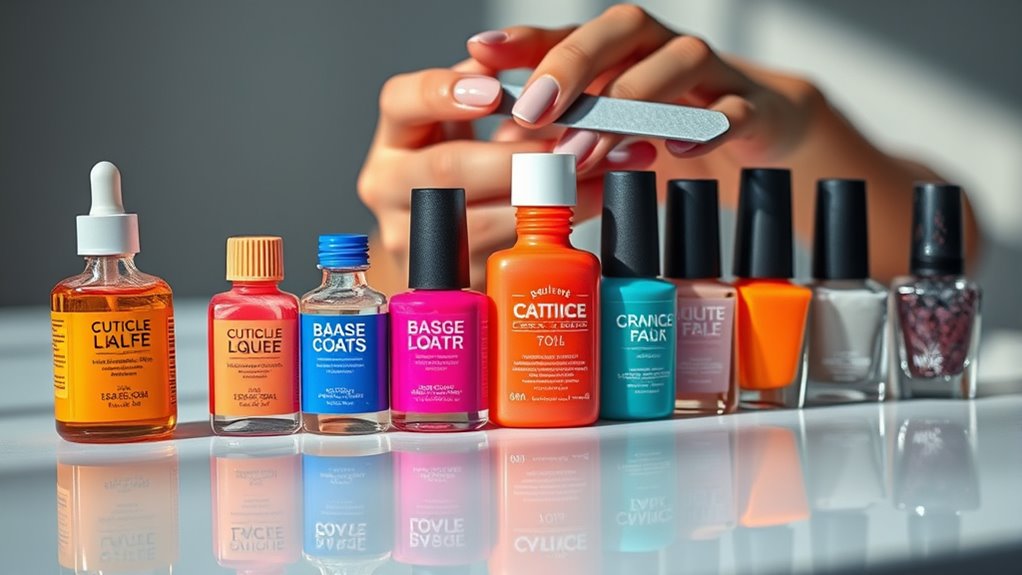
Are you selecting the right nail products to guarantee healthy, beautiful nails? The key is to choose items that suit your nail type and avoid harsh chemicals. Look for formulas labeled as non-toxic, free from formaldehyde, toluene, and DBP, which can weaken nails over time. Consider nourishing base coats and strengthening topcoats that contain ingredients like biotin or keratin. When picking nail polish, opt for shades that are long-lasting and easy to remove without damaging your nails. Always check the labels for quality and safety standards. If you have sensitive skin or allergies, choose hypoallergenic products. Investing in the right tools, like a gentle file and cuticle oil, complements your product choices and helps maintain overall nail health. Incorporating pimple patches into your skincare routine can also help manage breakouts and keep your skin clear, supporting the overall health of your nails and skin. Additionally, understanding the importance of home cinema technology can inspire you to create a relaxing environment that promotes overall wellness and self-care. Proper lifestyle habits, including a balanced diet and hydration, play a crucial role in maintaining strong and healthy nails. Staying informed about grocery savings strategies can also reduce financial stress, allowing you to invest more in quality nail care products.
Nail Care Routine for Strength and Growth

A consistent nail care routine can remarkably boost your nails’ strength and promote healthy growth. To see real results, stick to these key steps:
- Keep nails moisturized with cuticle oil or nourishing hand cream daily to prevent dryness and brittleness.
- Regularly file nails in one direction to avoid splits and weaken spots.
- Take biotin supplements or incorporate nail-strengthening vitamins into your diet to support internal growth.
- Using proper tools and techniques when caring for your nails minimizes damage and maintains their health.
- Incorporate AI-driven insights to identify personalized nail care routines based on your nail condition and lifestyle, optimizing your results.
Avoid harsh chemicals and excessive water exposure, which can weaken nails over time. Instead, use gentle, acetone-free polish removers and wear gloves during chores. Consistency is essential—by following these simple steps, you’ll strengthen your nails and encourage healthy, ongoing growth.
Tips for Preventing Nail Damage and Breakage
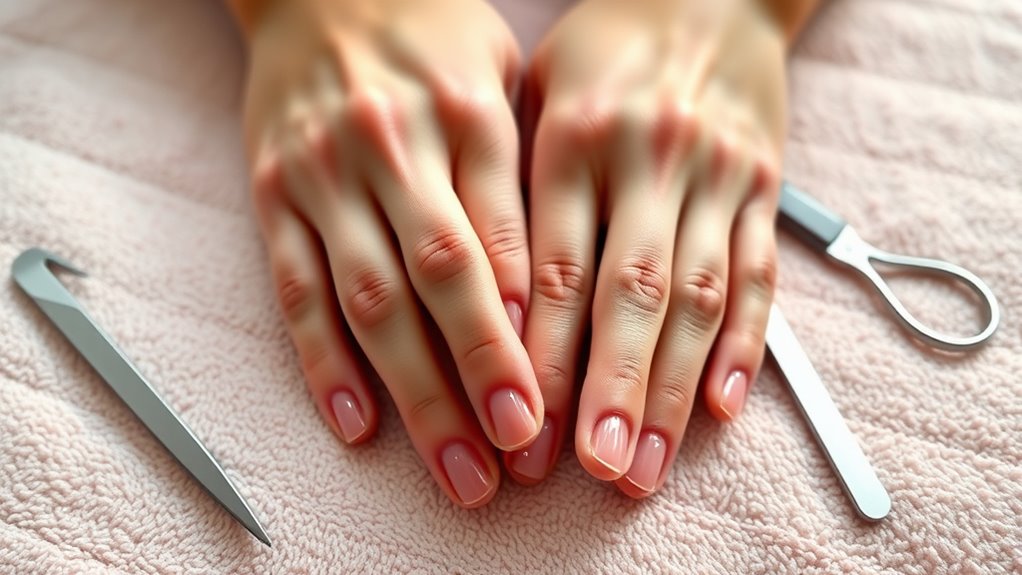
To keep your nails strong and less prone to breakage, focus on proper hydration and avoid letting them dry out. Use gentle filing techniques to prevent damage, and steer clear of harsh chemicals that can weaken your nails. These simple steps can make a big difference in maintaining healthy, resilient nails. Additionally, incorporating protective styling techniques can further enhance nail strength and prevent damage over time. Regularly using nail strengthening treatments can also provide extra support and help maintain overall nail health. Ensuring you get adequate nutrients like biotin and vitamins can also significantly contribute to stronger nails and overall nail vitality. Moreover, understanding the benefits of glycolic acid in exfoliating dead skin around nails can promote healthier cuticles and improve overall nail appearance.
Proper Nail Hydration
Ever wondered why some nails stay strong and healthy while others easily break? Proper hydration plays a vital role. When your nails are well-moisturized, they’re less likely to become brittle and prone to splitting. To keep your nails hydrated:
- Use cuticle oils or nourishing hand creams daily to lock in moisture and prevent dryness. Regular application helps maintain the moisture barrier, which protects nails from external damage.
- Drink plenty of water—aim for at least 8 glasses a day—to hydrate your entire body, including your nails.
- Limit exposure to harsh chemicals and detergents by wearing gloves when cleaning, reducing moisture loss and damage.
- Staying informed about AI safety measures can help ensure that health and beauty products are developed responsibly, supporting overall well-being.
Staying consistent with these habits helps maintain flexible, resilient nails that resist breakage. Proper hydration isn’t just about appearance—it’s the foundation for healthy, long-lasting nails.
Gentle Filing Techniques
Maintaining well-hydrated nails sets the foundation for healthy nail care, but how you treat your nails during filing also makes a big difference. Use a gentle approach to prevent damage and breakage. Always file in one direction, avoiding back-and-forth sawing, which weakens nails. Use a fine-grit file to reduce rough edges smoothly. Be mindful of pressure—pressing too hard can cause splits. Keep your files clean to prevent bacterial buildup. Regularly incorporating sound healing techniques can promote overall relaxation and well-being, indirectly supporting healthier nails. Here’s a quick guide:
| Technique | Benefit | Tip |
|---|---|---|
| File in one direction | Prevents splitting | Use gentle, steady strokes |
| Use fine-grit files | Reduces nail trauma | Replace when worn out |
| Avoid metal files | Less damaging | Opt for glass or emery |
| Keep files clean | Maintains hygiene | Wash regularly |
Follow these tips for stronger, healthier nails.
Avoid Harsh Chemicals
Harsh chemicals in nail products can weaken and damage your nails over time, increasing the risk of breakage and peeling. To protect your nails, avoid products with ingredients like formaldehyde, toluene, and acetone. These chemicals strip moisture and weaken the nail structure. Instead, choose formulas labeled as “free of harsh chemicals” or “gentle.” Here are some tips:
- Read labels carefully before purchasing nail polish or remover.
- Opt for acetone-free nail polish removers to prevent dryness.
- Use nourishing base coats and topcoats with strengthening ingredients.
Best Practices for Nail Polishing and Removal

To achieve a flawless manicure, mastering the right techniques for nail polishing and removal is essential. When applying polish, start with clean, dry nails. Use a base coat to protect your nails and ensure smoother color application. Apply thin layers of polish, letting each dry before adding the next, to prevent smudging and bubbling. Finish with a top coat for shine and durability. When removing polish, avoid harsh scrubbing. Soak a cotton ball in remover and gently press it onto your nail for a few seconds before wiping away. Use a non-acetone remover if your nails are delicate, as it’s gentler. Always moisturize your nails and cuticles after removal to keep them healthy. Proper technique prevents damage and keeps your nails looking fresh and beautiful.
Nutritional Tips for Healthy Nails
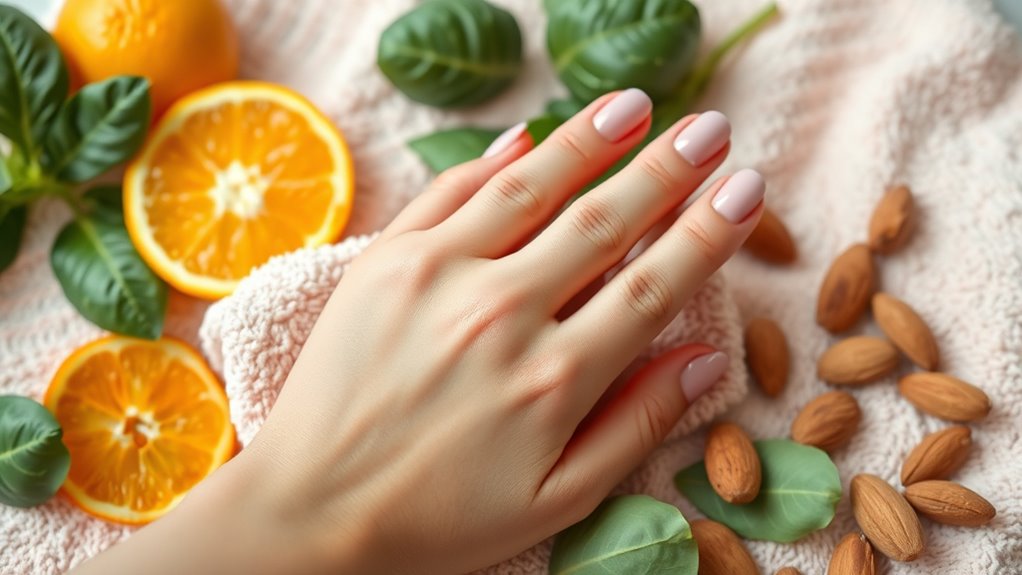
Eating a balanced diet rich in essential nutrients is key to keeping your nails strong and healthy. Proper nutrition provides the building blocks your nails need to grow and resist damage. Focus on including these crucial nutrients:
A balanced diet with essential nutrients keeps your nails strong, healthy, and resilient from the inside out.
- Biotin – Strengthens nails and promotes growth. Include eggs, nuts, and whole grains.
- Protein – Nails are made of keratin, so adequate protein intake supports nail structure. Incorporate lean meats, beans, and dairy.
- Vitamins A, C, and E – Support nail health and repair. Eat plenty of colorful fruits and vegetables, citrus, and leafy greens.
Sticking to these nutritional tips helps your nails stay resilient and beautiful from the inside out. Remember, healthy nails start with good nutrition.
When to Seek Professional Nail Care Assistance
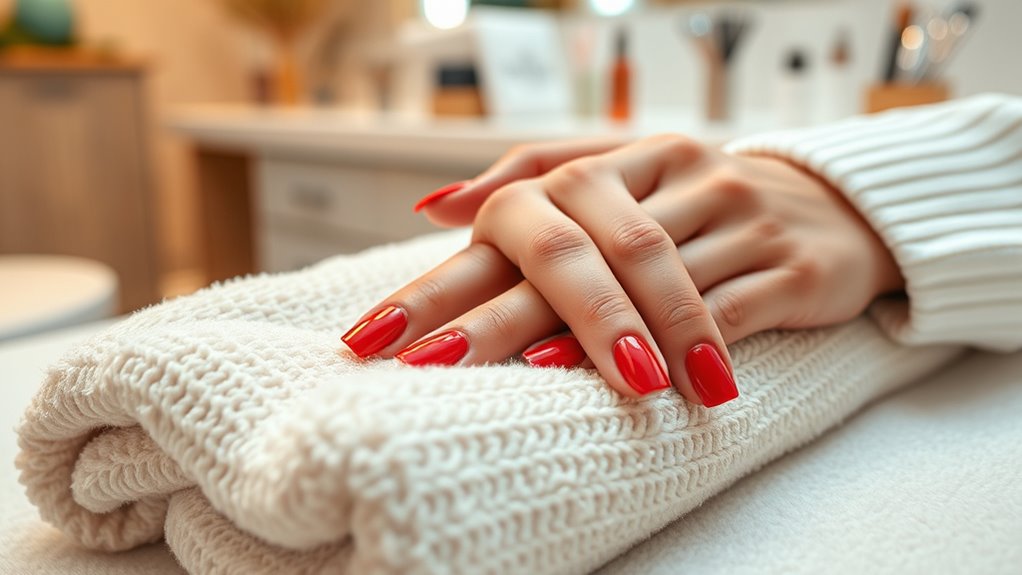
While many nail issues can be managed at home, it’s important to recognize when professional nail care assistance is necessary. If you notice persistent pain, swelling, or redness around your nails, don’t delay seeking help. Severe or ongoing fungal infections, such as thickened, discolored, or crumbling nails, require a professional diagnosis and treatment. If your nails are lifting, splitting excessively, or experiencing abnormal changes, a nail specialist can identify underlying issues. Also, if you’ve experienced injury or trauma to your nails, consult a professional before attempting DIY fixes. Regular check-ins with a licensed nail technician or dermatologist ensure your nails stay healthy and prevent minor issues from worsening. Trust your instincts—when in doubt, seek expert advice to maintain superior nail health.
Frequently Asked Questions
How Often Should I Trim My Nails for Optimal Health?
You should trim your nails regularly to keep them healthy and looking good. Typically, trimming every one to two weeks works well, but it depends on how fast your nails grow. If you notice your nails getting too long or uneven, trim them sooner. Use clean, sharp scissors or clippers, and avoid cutting too close to the skin to prevent injury. Consistent trimming helps prevent breakage and keeps nails in great shape.
Are There Natural Remedies to Strengthen Weak Nails?
Think of your nails as tiny gardens needing tender care. To strengthen weak nails naturally, you can soak them in olive oil or coconut oil, which acts like a nourishing rain, feeding their roots. Keep your nails moisturized, eat a balanced diet rich in biotin and vitamins, and avoid harsh chemicals. These simple remedies can help your nails grow stronger and healthier, like a well-tended garden bursting with robustness.
Can Nail Polish Cause Long-Term Damage?
You might wonder if nail polish causes long-term damage. It can if you don’t give your nails breaks or use harsh formulas. Prolonged use of polish with formaldehyde, toluene, or DIPY can weaken nails over time. To protect your nails, take breaks from polish, opt for breathable formulas, and always remove polish gently. Proper nail care helps keep your nails healthy and beautiful in the long run.
What Are Signs of Fungal Infections on Nails?
Ever noticed your nails changing color or shape? These are signs of fungal infections. You might see white, yellow, or brown spots, thickened nails, or crumbling edges. Sometimes, nails become brittle or emit a foul smell. If you notice these symptoms, don’t ignore them. Fungal infections need treatment to prevent spreading or worsening. Regularly check your nails and seek medical advice if you suspect an infection.
How Can I Prevent Yellowing of My Nails?
To prevent yellowing of your nails, you should keep them clean and dry, as moisture promotes discoloration. Avoid smoking, as tobacco can stain nails, and limit exposure to harsh chemicals by wearing gloves. Regularly use a gentle nail whitening treatment or lemon juice to brighten your nails. Maintain a healthy diet rich in vitamins, especially biotin, to support nail strength and color. Consistent care keeps your nails looking fresh and vibrant.
Conclusion
Taking good care of your nails keeps them strong and beautiful. Did you know that over 50% of women experience nail breakage at some point? By understanding your nail structure, maintaining proper hygiene, and nourishing your nails from within, you can prevent damage and enjoy healthier nails. Remember, consistent care and professional help when needed make all the difference. Start implementing these tips today for nails that truly shine!
